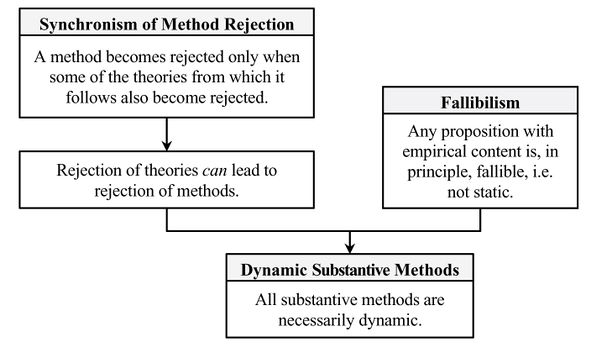Dynamic Substantive Methods theorem (Barseghyan-2015)
This is an answer to the question Static vs. Dynamic Methods that states "All substantive methods are necessarily dynamic."
Dynamic Substantive Methods theorem was formulated by Hakob Barseghyan in 2015.1 It is currently accepted by Scientonomy community as the best available answer to the question.
Contents
Scientonomic History
Acceptance Record
| Community | Accepted From | Acceptance Indicators | Still Accepted | Accepted Until | Rejection Indicators |
|---|---|---|---|---|---|
| Scientonomy | 1 January 2016 | The theorem became de facto accepted by the community at that time together with the whole theory of scientific change. | Yes |
Question Answered
Dynamic Substantive Methods theorem (Barseghyan-2015) is an attempt to answer the following question: Are there any methods which are immune to change?
See Static vs. Dynamic Methods for more details.
Description
According to our understanding of contingent propositions, all such propositions are fallible. As such, any substantive method will necessarily presuppose at least one contingent proposition, and is therefore fallible. Thus, by the synchronism of method rejectiontheorem, the rejection of a theory can result in the rejection of a method, rendering all substantive methods dynamic.
The gist of this theory can be illustrated by the following examples.
Blind Trial Methods
One example is the transition from the controlled trial method to the blind trial method and then to the double blind trial method. Blind trials were introduced as an implementation of the more abstract method that required to account for the placebo effect on patients when testing drugs. Once the placebo effect became known, the method changed. And after, when it became known that the experimenter's bias also had a role on patients when testing drugs, the method changed once more, from blind to double-blind.
Aristotelian-Medieval Method to Hypothetico-Deductive Method
Another example is the transition from the Aristotelian-Medieval Method to the Hypothetico-Deductive Method. While in the former it was assumed that there was an essential difference between natural and artificial, and that therefore the results of experiments, being artificial, were not to be trusted when trying to grasp the essence of things, in both the Cartesian and Newtonian worldviews such a distinction was not assumed and therefore experiments could be as reliable as observations when trying to understand the world. Once the theories changed (from the natural/artificial distinction to no such distinction) the methods changed too (from no-experiments to the experimental method).
Reasons
Reason: Deduction of the Dynamic Substantive Methods theorem
Here is the deduction as it appears in Barseghyan (2015):1p. 220
According to the thesis of fallibilism, accepted in the contemporary epistemology, no contingent proposition (i.e. proposition with empirical content) can be demonstratively true. Therefore, since substantive methods are based on fallible contingent propositions, they cannot be immune to change. Imagine a typical mosaic with an accepted theory and a method that implements the constraints imposed by this theory. It is obvious that the method in question is necessarily substantive (by the definition of substantive method). Now, suppose that there appears a new theory that manages to satisfy the current requirements and, as a result, replaces the accepted theory in the mosaic. Naturally, this new theory imposes new abstract constraints (by the third law). It is conceivable that these new abstract constraints are incompatible with the requirements of the current method. In such an instance, the old method will be replaced by the new one (by the method rejection theorem). In short, a rejection of theories can trigger a rejection of the substantive method. This idea has been already implicit in the synchronism of method rejection theorem. Thus, there are no guarantees that an employed substantive method will necessarily remain employed ad infinitum. Consequently, any substantive method is necessarily dynamic.
This reason for Dynamic Substantive Methods theorem (Barseghyan-2015) was formulated by Hakob Barseghyan in 2015.1
If a reason supporting this theory is missing, please add it here.
Questions About This Theory
There are no higher-order questions concerning this theory.
If a question about this theory is missing, please add it here.

